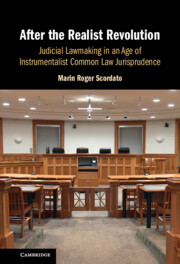 After the Realist Revolution
After the Realist Revolution The Tarasoff Case as an Exemplar
Published online by Cambridge University Press: 02 May 2025
In the wake of the legal realist repudiation of traditional formalism, there existed an absence of a satisfying conceptual account of appellate court lawmaking in America. This void was eventually filled, almost by default, by a notion of appellate court lawmaking that is a kind of idealized version of legislative lawmaking whereby appellate courts choose to make one plausible version or another of legal doctrine the authoritative law based on their balancing of societal costs and benefits deemed to be associated with each possibility. This approach evaluates each competing version of common law in terms of the degree to which each best advances the underlying social purposes sought to be advanced by the doctrinal area in question. This newly embraced approach is often called instrumentalism.
This chapter provides a detailed description and analysis of a famous instance of modern instrumentalist analysis by a high-profile appellate court. The case is Tarasoff v. Regents of the University of California, decided by the California Supreme Court in 1976, and announcing for the first time in the United States the existence of a formal tort law duty for a therapist to warn the intended victim of violent behavior by a patient.
To save this book to your Kindle, first ensure [email protected] is added to your Approved Personal Document E-mail List under your Personal Document Settings on the Manage Your Content and Devices page of your Amazon account. Then enter the ‘name’ part of your Kindle email address below. Find out more about saving to your Kindle.
Note you can select to save to either the @free.kindle.com or @kindle.com variations. ‘@free.kindle.com’ emails are free but can only be saved to your device when it is connected to wi-fi. ‘@kindle.com’ emails can be delivered even when you are not connected to wi-fi, but note that service fees apply.
Find out more about the Kindle Personal Document Service.
To save content items to your account, please confirm that you agree to abide by our usage policies. If this is the first time you use this feature, you will be asked to authorise Cambridge Core to connect with your account. Find out more about saving content to Dropbox.
To save content items to your account, please confirm that you agree to abide by our usage policies. If this is the first time you use this feature, you will be asked to authorise Cambridge Core to connect with your account. Find out more about saving content to Google Drive.